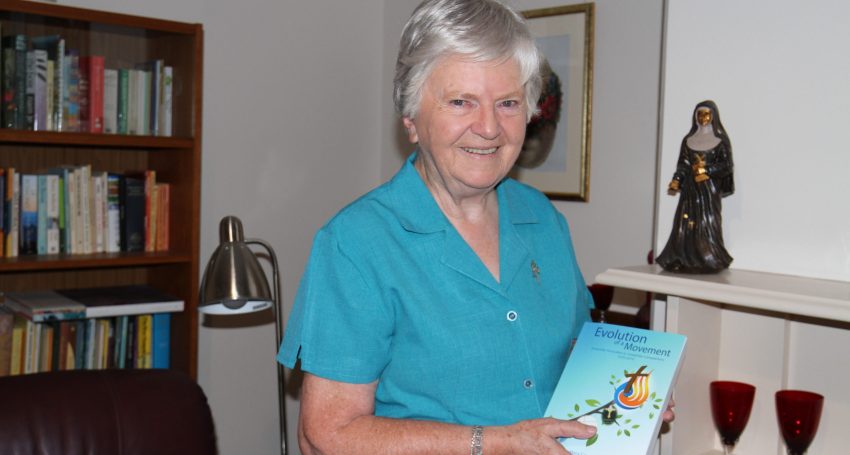Another chapter in the Josephite story
People
Sr Mary Cresp rsj is a great believer in the value of storytelling.

“Stories are one way we get encouragement from each other,” she says.
“The Gospel is a story, and right from the beginning we, like the first peoples of Australia, have learnt about the meaning of life through stories.”
The Josephite Sister is well-versed on the subject, having written nine books over the past two decades and many articles and research papers before that. Her most recent ‘story’ is a timely account of how one religious order recognised its charism as shared with lay people seeking to be witnesses to the Gospel.
Advertisement
Launched in December by Archbishop Patrick O’Regan, himself a Josephite Companion, Evolution of a Movement – Josephite Associates to Josephite Companions 1979-2019 is part of a series of Josephite books published by ATF Press.
Sr Mary says she hopes readers will “become more aware that all the baptised are called to be on mission, that they will find encouragement with others who share the Josephite spirit, and that it is in building these relationships that we find life’s meaning”.
Quoting politician Henry Parkes who described the Sisters of St Joseph as ‘white ants – once they get into a place you can’t starve them out’, she adds: “We have to be like white ants and really make a difference to our society by making a difference in the areas in which we are living and working.”
In the book, Sr Mary describes the evolution of Josephite Associates to Josephite Companions as a ‘story of relationships’.
‘Relationships are forged when we hear each other’s stories,’ she writes.
‘So it is important for all who live in the spirit of St Joseph that we hear the story of the Josephite Associates.’
Despite the constraints of COVID, Sr Mary was in contact with more than 200 people while researching the book and she is grateful to them, including the various archivists who assisted her via email.
Sr Mary’s interest, and obvious skill, in writing follows a long career in teaching in primary and secondary schools and parish work. She studied theology, including in the USA and Canada where she gained her Masters in Theology and Spirituality, and taught at St Francis Xavier Seminary and the Adelaide College of Divinity until she was elected in 1989 as Congregational leader.
One of seven children raised on a Riverland fruit block that was destroyed by the 1956 floods, Sr Mary was eight years old when she decided to become a Sister.
“That proved to be a dilemma at the time because I had a boyfriend who used to bring me chocolate frogs; that was a big problem for me,” she laughs.
“We had a day of retreat at school and the priest asked me if I’d be a Sister and I said ‘I suppose so’; I had this little thing as a small child that my word was myself, so if I gave my word I had to do it. It’s something that has stuck with me all my life.”
Advertisement
After attending St Joseph’s School, Berri, she went to the juniorate at Aldgate and remembers returning to the fruit block to find the house under water. It was nine months before the family could move back into the house and by then the fruit trees were dead.
At 16 she entered the convent, two years before the Second Vatican Council opened and challenged religious orders to better understand why and how their communities came into being. Sr Mary says as a religious order the Josephites “grew into it”.
“Our schooling as young people was, theologically, in the time of the mystical body of Christ so we grew naturally into a Church that produced Vatican II,” she says.
“When we find people pulling back from that vision, it is upsetting to say the least.
“Instead of the Church being an instrument and a sign of God’s grace amongst us, it becomes an end in itself.”
She says the same “inspiration of the Holy Spirit that said you have to be among the people of God” is part of the Josephite charism that “we carry into our time and reinterpret”.
Referring to the “phenomenon of big numbers” in religious orders in the post-war era, Sr Mary says through the ages it was often small communities of 20 or so that had a big impact.
With consecrated life part of the Church since its “very early days”, she expects there will always be a place for it but not to the detriment of the whole Church.
“I don’t know what consecrated life will look like in the future; we just have to be open to what we are called to be in the present time,” she says.
As for Josephite Companions, she cites South Australia as a place that is “doing it well” through a good leadership committee and its focus on mission and articulating God’s presence in our world.
There are about 300 Companions in South Australia and more than 3000 worldwide.
“Companions is a way of being Catholic or being Church that suits their conditions in life and gives meaning to what they do,” she says. “And they’re encouraged by each other.”
Evolution of a Movement is available from the Mary MacKillop Museum Bookshop at Kensington and through AFT Press (www.aftpress.com)








Comments
Show comments Hide comments